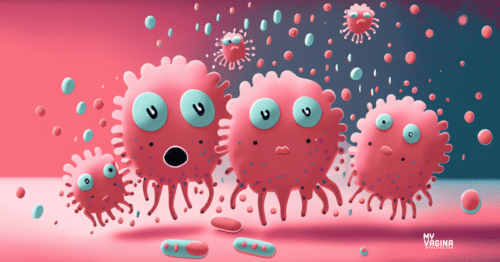Cleaning up your diet to support healthy vaginal bacterial colonies
We look over some ways to improve your good bacterial colonies using diet.
Managing stress in BV
Figuring out how to manage stress when you are treating BV.
Study: thyme cream for bacterial vaginosis
A thyme-like herb was trialled against standard antibiotic treatment for BV, and has come out slightly under par in a direct comparison.
Study: can calendula cure BV?
When treating BV, a calendula cream was just as effective as antibiotics one week after application, and can be used as an alternative treatment to antibiotics.
Review: Fluomizin (dequalinium chloride)
Fluomizin is a vaginal tablet used for vaginal infections, primarily in the European Union.
Using dequalinium chloride (Fluomizin) to treat vaginal infections
Dequalinium chloride (Fluomizin) is a solid broad-spectrum non-antibiotic antimicrobial used vaginally for infections of all kinds. Dequalinium chloride is commonly used in throat lozenges.
Enterococcus faecium in vaginal infections
E. faecium is a bacteria that can contribute to or cause vaginal or urinary tract infections.
Comparison table – what type of bad vag do I have? (BV, AV, Trich, Yeast)
Easy reference table for determining your vaginal infection.
Megaspheara species
Megasphaera species are highly correlated with bacterial vaginosis.
Study: does BV cause infertility in women?
A study looked into rates of certain types of female infertility and how that related to BV.
Study: Gardnerella vaginalis – links with male infertility?
Researchers look into the sperm quality of infertile men carrying G. vaginalis.
Evidence for men carrying Gardnerella vaginalis in the urethra
A couple of older studies look at G. vaginalis in the urethras of men.
How gentian violet works
An old study examines gentian violet's antimicrobial properties against bacteria.
Oral sex and BV transmission
We discuss the idea of BV-bacteria being transmissible by mouth, how that occurs, and review the research into BV-related bacteria colonising the mouth.
Using gentian violet vaginally for vulvovaginal infections
Gentian violet can be used as a treatment for some vaginal infections with great effect, particularly those caused by gram-positive bacteria and yeasts. Very messy, but a great old-school gynaecologist antimicrobial.
Understanding and using povidone-iodine (Betadine) for vaginal infections
Learn about the effectiveness of povidone-iodine (Betadine) vaginally for use in infections such as BV, AV and yeast.
Vitamin D and bacterial vaginosis (BV)
Vitamin D supplementation can help women who have asymptomatic BV, but it has no effect on those with recurrent BV.
How to fill your own 600mg boric acid capsules at home
You can inexpensively fill your own vegetable caps with boric acid at home.
Where can I buy boric acid from?
Woman Seeking Boric Acid.
Antibiotic treatment of men with partners with BV – do they work?
We examine the evidence regarding the effect of antibiotic treatment of male sexual partners of women with BV.





